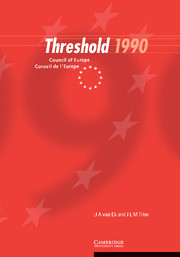Book contents
- Frontmatter
- Contents
- Preface
- Introduction
- 1 The objective: levels of specificity
- 2 The objective: general characterisation
- 3 The objective: extended characterisation
- 4 The objective: components of the specification
- 5 Language functions
- 6 General notions
- 7 Specific notions
- 8 Verbal exchange patterns
- 9 Dealing with texts: reading and listening
- 10 Writing
- 11 Sociocultural competence
- 12 Compensation strategies
- 13 Learning to learn
- 14 Degree of skill
- APPENDICES
8 - Verbal exchange patterns
Published online by Cambridge University Press: 26 February 2010
- Frontmatter
- Contents
- Preface
- Introduction
- 1 The objective: levels of specificity
- 2 The objective: general characterisation
- 3 The objective: extended characterisation
- 4 The objective: components of the specification
- 5 Language functions
- 6 General notions
- 7 Specific notions
- 8 Verbal exchange patterns
- 9 Dealing with texts: reading and listening
- 10 Writing
- 11 Sociocultural competence
- 12 Compensation strategies
- 13 Learning to learn
- 14 Degree of skill
- APPENDICES
Summary
Exponents of single language functions may occur in isolation. ‘Stop!’ as an order, and ‘Look out!’ as a warning, are obvious examples. On the whole, however, function exponents are more likely to occur in sequences. Such sequences will usually exhibit certain regularities in the order of their elements. Thus, an apology will very often be followed by an explanation: ‘I'm sorry I'm late, but I had to see my dentist first.’ Such more or less regularly occurring combinations may be referred to as patterns. Monologues may be thus patterned, if only in that they may start with an utterance calling for attention and end with one signalling termination. With regard to oral communication involving contributions by the learner the emphasis, at Threshold Level, is not so much on monologues as on verbal exchanges between two, or more than two, speakers. In such exchanges the participants may mesh their contributions in accordance with certain conventions. We then speak of verbal exchange patterns. It is a characteristic of these patterns that they are variable, in that a conversation may move in various directions. Especially when they are very short, however, involving only two or three utterances, they may also be standardised. This may be said, for instance, of the typical greeting + response pattern occurring when two people pass each other in the street. The large majority of the verbal exchange patterns, however, that are relevant to Threshold Level learners in the light of the objective are variable.
- Type
- Chapter
- Information
- Threshold 1990 , pp. 82 - 87Publisher: Cambridge University PressPrint publication year: 1998

